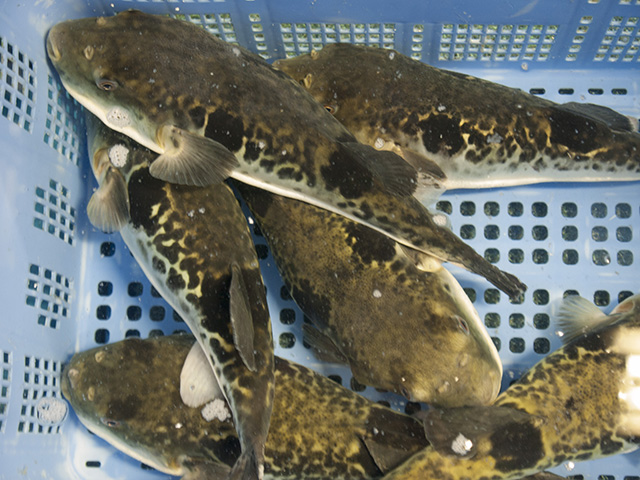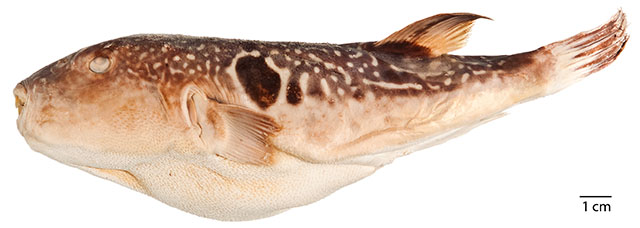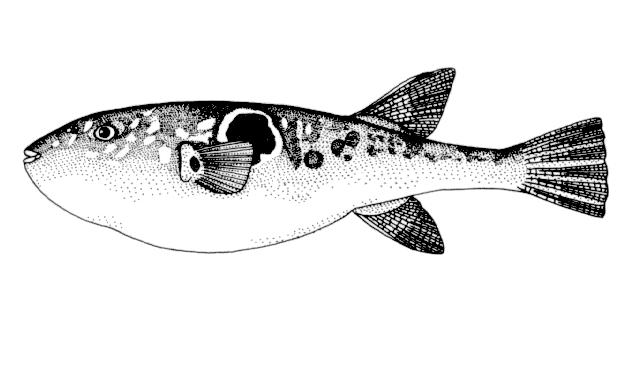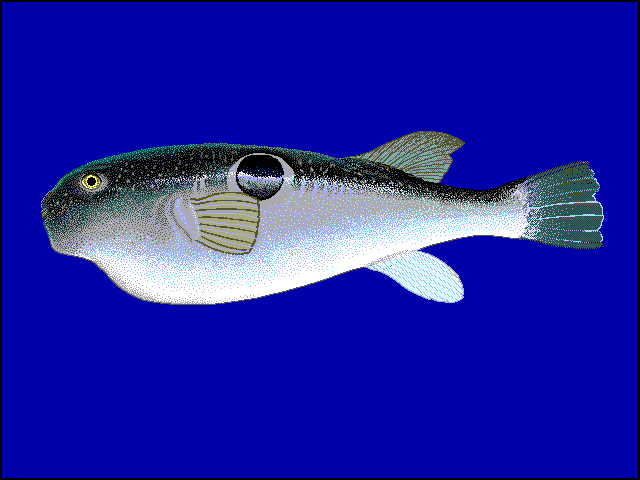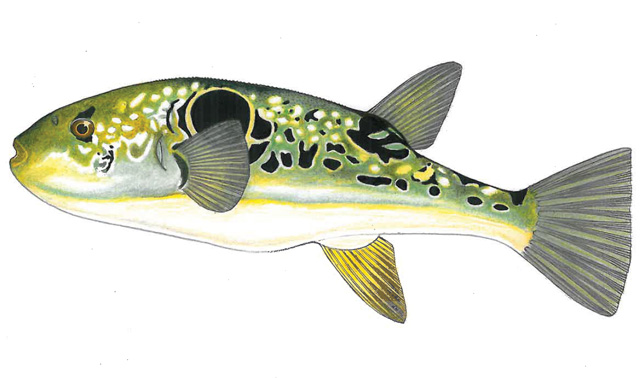Takifugu
rubripes
(Temminck &
Schlegel,
1850)
Japanese pufferfish
View all media / Upload your photos and videos
Expand all
Classification / Names
Teleostei (teleosts) > Tetraodontiformes (Puffers and filefishes) >
Tetraodontidae (Puffers)
> Tetraodontinae
Etymology: Takifugu: A Japanese word with several meanings; taki = waterfall + fugu = fish; it could be also understood as taki = to be cooked in liquid + fugu = a venomous fish
More on authors:
Temminck &
Schlegel.
Environment / milieu / depth range / climate zone / distribution range
Marine; brackish; freshwater; demersal; non-migratory; temperate; 46°N - 21°N119°E - 142°E.
Distribution
Northwest Pacific: western part of the Sea of Japan and the East China and Yellow seas northward to Muroran, Hokkaido, Japan.
Maps

Takifugu rubripes / Native range
AquaMaps Data sources:
GBIF
OBIS
This map was computer-generated and has not yet been reviewed.

Takifugu rubripes / Suitable habitat
AquaMaps Data sources:
GBIF
OBIS
This map was computer-generated and has not yet been reviewed.

Takifugu rubripes / Point map
AquaMaps Data sources:
GBIF
OBIS
This map was computer-generated and has not yet been reviewed.

Takifugu rubripes / Year 2050
AquaMaps Data sources:
GBIF
OBIS
This map was computer-generated and has not yet been reviewed.
Size / Weight / Age
Short description
Biology
Adults are found in inlet waters, occasionally entering brackish waters. Fingerlings are often seen in brackish river mouths (Ref. 58920). Move offshore with growth. Breed in the sea (Ref. 58920) from March to May; attach eggs to rocks in shingly areas at depths of around 20 m. Liver and ovaries extremely toxic, intestines slightly toxic; flesh, skin and testes not poisonous. Juveniles resemble Takifugu niphobles (Ref. 637). A prized food fish in Japan. Said to be commercially cultured in Japan at present. Used in Chinese medicine (Ref. 12166). One of the first vertebrates whose genome has been sequenced completely, 31,059 genes coding for 33,609 proteins (Ref. 58917).
Main reference
Masuda, H., K. Amaoka, C. Araga, T. Uyeno and T. Yoshino 1984 The fishes of the Japanese Archipelago. Vol. 1. Tokai University Press, Tokyo, Japan. 437 p. (text). (Ref. 559)
IUCN Red List Status (Ref. 125652)
Near Threatened (NT); date assessed: June 10 2011
CITES (Ref. 131153)
Not Evaluated
CMS (Ref. 116361)
Not Evaluated
Threat to humans
Poisonous to eat (Ref. 637)
More information
- Countries
- FAO areas
- Ecosystems
- Occurrences
- Introductions
- Stocks
- Ecology
- Diet
- Food items
- Food consumption
- Ration
- Common names
- Synonyms
- Metabolism
- Predators
- Ecotoxicology
- Reproduction
- Maturity
- Spawning
- Spawning aggregation
- Fecundity
- Eggs
- Egg development
- Age/Size
- Growth
- Length-weight
- Length-length
- Length-frequencies
- Morphometrics
- Morphology
- Larvae
- Larval dynamics
- Recruitment
- Abundance
- References
- Aquaculture
- Aquaculture profile
- Strains
- Genetics
- Allele frequencies
- Heritability
- Diseases
- Processing
- Mass conversion
- Vision
- Pictures
- Stamps, Coins Misc.
- Sounds
- Ciguatera
- Speed
- Swim. type
- Gill area
- Otoliths
- Brains
Estimates based on models
Preferred temperature (Ref. 123201): 13.5 - 23, mean 19 °C (based on 96 cells).
Phylogenetic diversity index (Ref. 82804): PD50 = 0.5 [Uniqueness, from 0.5 = low to 2.0 = high].
Bayesian length-weight: a=0.01622 (0.00726 - 0.03621), b=2.92 (2.74 - 3.10), in cm total length, based on LWR estimates for this (Sub)family-body shape (Ref. 93245).
Trophic level (Ref. 69278): 3.6 ±0.6 se; Based on food items.
Resilience (Ref. 120179): Medium, minimum population doubling time 1.4 - 4.4 years (K=0.15-0.17; assuming tm<5).
Fishing vulnerability (Ref. 59153): Low to moderate vulnerability (30 of 100).
Price category (Ref. 80766): Very high; Very questionable: based on ex-vessel price for species in this family.
Nutrients (Ref. 124155): Calcium = 33.8 [12.1, 75.6] mg/100g; Iron = 0.417 [0.219, 0.855] mg/100g; Protein = 18.9 [16.7, 21.2] %; Omega3 = 0.664 [0.289, 1.400] g/100g; Selenium = 17.1 [7.6, 37.7] μg/100g; VitaminA = 5.76 [2.01, 17.07] μg/100g; Zinc = 0.506 [0.365, 0.732] mg/100g (wet weight);


